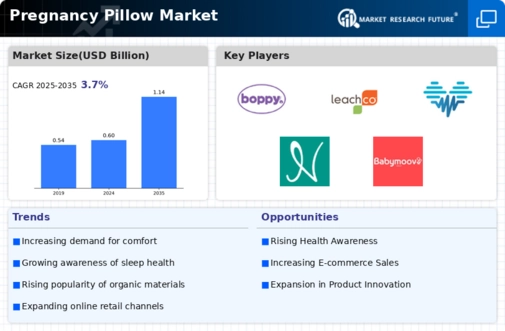-
EXECUTIVE SUMMARY
-
MARKET INTRODUCTION
-
Definition
-
Scope of the Study
- Research Objective
- Assumptions
- Limitations
-
RESEARCH METHODOLOGY
-
Overview
-
Data Mining
-
Secondary Research
-
Primary Research
- Primary Interviews and Information Gathering Process
- Breakdown of Primary Respondents
-
Forecasting Technique
-
Market Size Estimation
- Bottom-Up Approach
- Top-Down Approach
-
Data Triangulation
-
Validation
-
MARKET DYNAMICS
-
Overview
-
Drivers
-
Restraints
-
Opportunities
-
MARKET FACTOR ANALYSIS
-
Value Chain Analysis
-
Porter’s Five Forces Analysis
- Bargaining Power of Suppliers
- Bargaining Power of Buyers
- Threat of New Entrants
- Threat of Substitutes
- Intensity of Rivalry
-
COVID-19 Impact Analysis
- Market Impact Analysis
- Regional Impact
- Opportunity and Threat Analysis
-
GLOBAL PREGNANCY PILLOW MARKET, BY TYPE
-
Overview
-
U-Shaped
-
C-Shaped
-
J-Shaped
-
Others
-
GLOBAL PREGNANCY PILLOW MARKET, BY MATERIAL
-
Overview
-
Hypoallergenic Fillings
-
Memory Foam
-
Organic Fillings
-
Others
-
GLOBAL PREGNANCY PILLOW MARKET, BY END USER
-
Overview
-
Hospitals
-
Maternity Homes & Clinics
-
Household
-
GLOBAL PREGNANCY PILLOW MARKET, BY REGION
-
Overview
-
North America
- US
- Canada
-
Europe
- Germany
- France
- UK
- Italy
- Spain
- Rest of Europe
-
Asia-Pacific
- China
- India
- Japan
- South Korea
- Australia
- Rest of Asia-Pacific
-
Rest of the World
- Middle East
- Africa
- Latin America
-
COMPANY LANDSCAPE
-
Overview
-
Competitive Analysis
-
Market Share Analysis
-
Major Growth Strategy in the Global Pregnancy Pillow Market
-
Competitive Benchmarking
-
Leading Players in Terms of Number of Developments in the Global Pregnancy Pillow Market
-
Key developments and Growth Strategies
- New Product Launch
- Merger & Acquisitions
- Joint Ventures
-
Major Players Financial Matrix
- Sales & Operating Income, 2022
- Major Players R&D Expenditure. 2022
-
COMPANY PROFILES
-
Boppy
- Company Overview
- Financial Overview
- Product Offered
- Key Developments
- SWOT Analysis
- Key Strategies
-
Cozy Bump
- Company Overview
- Financial Overview
- Product Offered
- Key Developments
- SWOT Analysis
- Key Strategies
-
Bluestone
- Company Overview
- Financial Overview
- Product Offered
- Key Developments
- SWOT Analysis
- Key Strategies
-
Queen Rose
- Company Overview
- Financial Overview
- Product Offered
- Key Developments
- SWOT Analysis
- Key Strategies
-
Mothers Lounge LLC
- Company Overview
- Financial Overview
- Product Offered
- Key Developments
- SWOT Analysis
- Key Strategies
-
PharMeDoc
- Company Overview
- Financial Overview
- Product Offered
- Key Developments
- SWOT Analysis
- Key Strategies
-
Leachco
- Company Overview
- Financial Overview
- Product Offered
- Key Developments
- SWOT Analysis
- Key Strategies
-
Bodycushion
- Company Overview
- Financial Overview
- Product Offered
- Key Developments
- SWOT Analysis
- Key Strategies
-
AllerEase
- Company Overview
- Financial Overview
- Product Offered
- Key Developments
- SWOT Analysis
- Key Strategies
-
Snoogle
- Company Overview
- Financial Overview
- Product Offered
- Key Developments
- SWOT Analysis
- Key Strategies
-
APPENDIX
-
References
-
Related Reports
-
-
LIST OF TABLES
-
GLOBAL PREGNANCY PILLOWMARKET, SYNOPSIS, 2019–2032
-
GLOBAL PREGNANCY PILLOWMARKET, ESTIMATES & FORECAST, 2019–2032 (USD MILLION)
-
GLOBAL PREGNANCY PILLOWMARKET, BY TYPE, 2019–2032 (USD MILLION)
-
GLOBAL PREGNANCY PILLOWMARKET, BY MATERIAL, 2019–2032 (USD MILLION)
-
GLOBAL PREGNANCY PILLOWMARKET, BY END USER, 2019–2032 (USD MILLION)
-
NORTH AMERICA: PREGNANCY PILLOWMARKET, BY TYPE, 2019–2032 (USD MILLION)
-
NORTH AMERICA: PREGNANCY PILLOWMARKET, BY MATERIAL, 2019–2032 (USD MILLION)
-
NORTH AMERICA: PREGNANCY PILLOWMARKET, BY END USER, 2019–2032 (USD MILLION)
-
US: PREGNANCY PILLOWMARKET, BY TYPE, 2019–2032 (USD MILLION)
-
US: PREGNANCY PILLOWMARKET, BY MATERIAL, 2019–2032 (USD MILLION)
-
US: PREGNANCY PILLOWMARKET, BY END USER, 2019–2032 (USD MILLION)
-
CANADA: PREGNANCY PILLOWMARKET, BY TYPE, 2019–2032 (USD MILLION)
-
CANADA: PREGNANCY PILLOWMARKET, BY MATERIAL, 2019–2032 (USD MILLION)
-
CANADA: PREGNANCY PILLOWMARKET, BY END USER, 2019–2032 (USD MILLION)
-
EUROPE: PREGNANCY PILLOWMARKET, BY TYPE, 2019–2032 (USD MILLION)
-
EUROPE: PREGNANCY PILLOWMARKET, BY MATERIAL, 2019–2032 (USD MILLION)
-
EUROPE: PREGNANCY PILLOWMARKET, BY END USER, 2019–2032 (USD MILLION)
-
GERMANY: PREGNANCY PILLOWMARKET, BY TYPE, 2019–2032 (USD MILLION)
-
GERMANY: PREGNANCY PILLOWMARKET, BY MATERIAL, 2019–2032 (USD MILLION)
-
GERMANY: PREGNANCY PILLOWMARKET, BY END USER, 2019–2032 (USD MILLION)
-
FRANCE: PREGNANCY PILLOWMARKET, BY TYPE, 2019–2032 (USD MILLION)
-
FRANCE: PREGNANCY PILLOWMARKET, BY MATERIAL, 2019–2032 (USD MILLION)
-
FRANCE: PREGNANCY PILLOWMARKET, BY END USER, 2019–2032 (USD MILLION)
-
ITALY: PREGNANCY PILLOWMARKET, BY TYPE, 2019–2032 (USD MILLION)
-
ITALY: PREGNANCY PILLOWMARKET, BY MATERIAL, 2019–2032 (USD MILLION)
-
ITALY: PREGNANCY PILLOWMARKET, BY END USER, 2019–2032 (USD MILLION)
-
SPAIN: PREGNANCY PILLOWMARKET, BY TYPE, 2019–2032 (USD MILLION)
-
SPAIN: PREGNANCY PILLOWMARKET, BY MATERIAL, 2019–2032 (USD MILLION)
-
SPAIN: PREGNANCY PILLOWMARKET, BY END USER, 2019–2032 (USD MILLION)
-
UK: PREGNANCY PILLOWMARKET, BY TYPE, 2019–2032 (USD MILLION)
-
UK: PREGNANCY PILLOWMARKET, BY MATERIAL, 2019–2032 (USD MILLION)
-
UK: PREGNANCY PILLOWMARKET, BY END USER, 2019–2032 (USD MILLION)
-
REST OF EUROPE: PREGNANCY PILLOWMARKET, BY TYPE, 2019–2032 (USD MILLION)
-
REST OF EUROPE: PREGNANCY PILLOWMARKET, BY MATERIAL, 2019–2032 (USD MILLION)
-
REST OF EUROPE: PREGNANCY PILLOWMARKET, BY END USER, 2019–2032 (USD MILLION)
-
ASIA-PACIFIC: PREGNANCY PILLOWMARKET, BY TYPE, 2019–2032 (USD MILLION)
-
ASIA-PACIFIC: PREGNANCY PILLOWMARKET, BY MATERIAL, 2019–2032 (USD MILLION)
-
ASIA-PACIFIC: PREGNANCY PILLOWMARKET, BY END USER, 2019–2032 (USD MILLION)
-
JAPAN: PREGNANCY PILLOWMARKET, BY TYPE, 2019–2032 (USD MILLION)
-
JAPAN: PREGNANCY PILLOWMARKET, BY MATERIAL, 2019–2032 (USD MILLION)
-
JAPAN: PREGNANCY PILLOWMARKET, BY END USER, 2019–2032 (USD MILLION)
-
CHINA: PREGNANCY PILLOWMARKET, BY TYPE, 2019–2032 (USD MILLION)
-
CHINA: PREGNANCY PILLOWMARKET, BY MATERIAL, 2019–2032 (USD MILLION)
-
CHINA: PREGNANCY PILLOWMARKET, BY END USER, 2019–2032 (USD MILLION)
-
INDIA: PREGNANCY PILLOWMARKET, BY TYPE, 2019–2032 (USD MILLION)
-
INDIA: PREGNANCY PILLOWMARKET, BY MATERIAL, 2019–2032 (USD MILLION)
-
INDIA: PREGNANCY PILLOWMARKET, BY END USER, 2019–2032 (USD MILLION)
-
AUSTRALIA: PREGNANCY PILLOWMARKET, BY TYPE, 2019–2032 (USD MILLION)
-
AUSTRALIA: PREGNANCY PILLOWMARKET, BY MATERIAL, 2019–2032 (USD MILLION)
-
AUSTRALIA: PREGNANCY PILLOWMARKET, BY END USER, 2019–2032 (USD MILLION)
-
SOUTH KOREA: PREGNANCY PILLOWMARKET, BY TYPE, 2019–2032 (USD MILLION)
-
SOUTH KOREA: PREGNANCY PILLOWMARKET, BY MATERIAL, 2019–2032 (USD MILLION)
-
SOUTH KOREA: PREGNANCY PILLOWMARKET, BY END USER, 2019–2032 (USD MILLION)
-
REST OF ASIA-PACIFIC: PREGNANCY PILLOWMARKET, BY TYPE, 2019–2032 (USD MILLION)
-
REST OF ASIA-PACIFIC: PREGNANCY PILLOWMARKET, BY MATERIAL, 2019–2032 (USD MILLION)
-
REST OF ASIA-PACIFIC: PREGNANCY PILLOWMARKET, BY END USER, 2019–2032 (USD MILLION)
-
REST OF THE WORLD: PREGNANCY PILLOWMARKET, BY TYPE, 2019–2032 (USD MILLION)
-
REST OF THE WORLD: PREGNANCY PILLOWMARKET, BY MATERIAL, 2019–2032 (USD MILLION)
-
REST OF THE WORLD: PREGNANCY PILLOWMARKET, BY END USER, 2019–2032 (USD MILLION)
-
MIDDLE EAST: PREGNANCY PILLOWMARKET, BY TYPE, 2019–2032 (USD MILLION)
-
MIDDLE EAST: PREGNANCY PILLOWMARKET, BY MATERIAL, 2019–2032 (USD MILLION)
-
MIDDLE EAST: PREGNANCY PILLOWMARKET, BY END USER, 2019–2032 (USD MILLION)
-
AFRICA: PREGNANCY PILLOWMARKET, BY TYPE, 2019–2032 (USD MILLION)
-
AFRICA: PREGNANCY PILLOWMARKET, BY MATERIAL, 2019–2032 (USD MILLION)
-
AFRICA: PREGNANCY PILLOWMARKET, BY END USER, 2019–2032 (USD MILLION)
-
LATIN AMERICA: PREGNANCY PILLOWMARKET, BY TYPE, 2019–2032 (USD MILLION)
-
LATIN AMERICA: PREGNANCY PILLOWMARKET, BY MATERIAL, 2019–2032 (USD MILLION)
-
LATIN AMERICA: PREGNANCY PILLOWMARKET, BY END USER, 2019–2032 (USD MILLION)
-
LIST OF FIGURES
-
RESEARCH PROCESS
-
MARKET STRUCTURE FOR THE GLOBAL PREGNANCY PILLOWMARKET
-
MARKET DYNAMICS FOR THE GLOBAL PREGNANCY PILLOWMARKET
-
GLOBAL PREGNANCY PILLOWMARKET, SHARE (%), BY TYPE, 2022
-
GLOBAL PREGNANCY PILLOWMARKET, SHARE (%), BY MATERIAL, 2022
-
GLOBAL PREGNANCY PILLOWMARKET, SHARE (%), BY END USER, 2022
-
GLOBAL PREGNANCY PILLOWMARKET, SHARE (%), BY REGION, 2022
-
NORTH AMERICA: PREGNANCY PILLOWMARKET, SHARE (%), BY REGION, 2022
-
EUROPE: PREGNANCY PILLOWMARKET, SHARE (%), BY REGION, 2022
-
ASIA-PACIFIC: PREGNANCY PILLOWMARKET, SHARE (%), BY REGION, 2022
-
REST OF THE WORLD: PREGNANCY PILLOWMARKET, SHARE (%), BY REGION, 2022
-
GLOBAL PREGNANCY PILLOWMARKET: COMPANY SHARE ANALYSIS (%), 2022
-
BOPPY: FINANCIAL OVERVIEW SNAPSHOT
-
BOPPY: SWOT ANALYSIS
-
COZY BUMP: FINANCIAL OVERVIEW SNAPSHOT
-
COZY BUMP: SWOT ANALYSIS
-
BLUESTONE: FINANCIAL OVERVIEW SNAPSHOT
-
BLUESTONE: SWOT ANALYSIS
-
QUEEN ROSE: FINANCIAL OVERVIEW SNAPSHOT
-
QUEEN ROSE: SWOT ANALYSIS
-
MOTHERS LOUNGE LLC: FINANCIAL OVERVIEW SNAPSHOT
-
MOTHERS LOUNGE LLC: SWOT ANALYSIS
-
PHARMEDOC: FINANCIAL OVERVIEW SNAPSHOT
-
PHARMEDOC: SWOT ANALYSIS
-
LEACHCO: FINANCIAL OVERVIEW SNAPSHOT
-
LEACHCO: SWOT ANALYSIS
-
BODYCUSHION: FINANCIAL OVERVIEW SNAPSHOT
-
BODYCUSHION: SWOT ANALYSIS
-
ALLEREASE: FINANCIAL OVERVIEW SNAPSHOT
-
ALLEREASE: SWOT ANALYSIS
-
SNOOGLE: FINANCIAL OVERVIEW SNAPSHOT
-
SNOOGLE: SWOT ANALYSIS










Leave a Comment